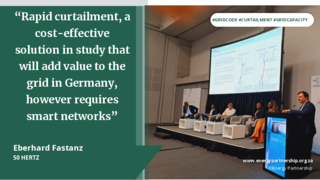Grid curtailment to support a sustainable energy supply highlighted at Windaba
The concept of grid curtailment and how it operates to optimise the use of existing power grids to accommodate a maximum amount of Renewable Energy Sources (RES), was a topic under discussion at the 12th Windaba Conference and Exhibition, held in Cape Town in October 2023.
The conference explored effective approaches for establishing a sustainable energy supply, for South Africa, and the broader African continent. Central to the discussions were the necessary investments and actions to expedite the construction or expansion of utility-scale wind projects, resolve the nation's energy crisis, and to plan accordingly.
The South African-German Energy Partnership participated actively in the conference and facilitated the contribution of Eberhard Fastanz, from the German company 50Hertz, at the session: “Wind Energy Implementation: Required Reading – Grid Code.”
During his presentation, Mr. Fastanz shed light on the concept of grid curtailment and how it operates in Germany. He presented the currently practised method as well as a new concept of rapid curtailment. Curtailment optimises the use of existing power grids to accommodate a maximum amount of Renewable Energy Sources (RES) in a constrained grid. It encompasses a moderate reduction of the output from RES plants in response to system security requirements or temporary constraints in transmission capacity. In the currently practised method, RES is ordered to reduce power according to the available (n-1)-capacity. As RES often don’t operate on peak power, the energy loss is rather small (e.g. a drastic reduction to only 50% peak power still delivers 70-80% of energy). After fault a direct intervention is not necessary. Mr. Fastanz highlighted that for the German grid, curtailment had emerged as a cost-effective solution to alleviate grid pressure, replace fossil fuel generators and reduce energy prices. It has been recognized as a prerequisite, or “the price to pay”, for integrating the surplus renewable electricity generated by RES plants. With grid expansion curtailment is lowered and thus the energy price reduced. Otherwise it would be fixed in the RES price.
In the more advanced method of rapid curtailment, instead of limiting RES to the (n-1)-capacity now the (n-0)-capacity is utilised (usually 20-30% higher). After fault a temporal overloading for around 2-4 minutes is accepted, in which RES rapidly decreases power. In case of a lack of sufficient total power in the grid, this allows for a maximum utilisation of RES without endangering the grid in (n-1)-situations; in case of sufficient power (some of its fast acting) this allows for overall higher transmission capacities. The presence of a smart grid and control centre as well as high reactive power supply (by RES) is needed.
The audience agreed that curtailment can be an efficient method. However, concerns were expressed regarding the implementation of rapid curtailment, particularly in South Africa, where it is challenged by the vast geographical spread of the grid network with power generation mainly concentrated on each end. The temporal line overload till RES reaction can thus lead to voltage issues in the central part of the grid. Mr. Fastanz agreed to the concerns and stated that RES (PV) in central locations might help to allow a (partial) implementation.


